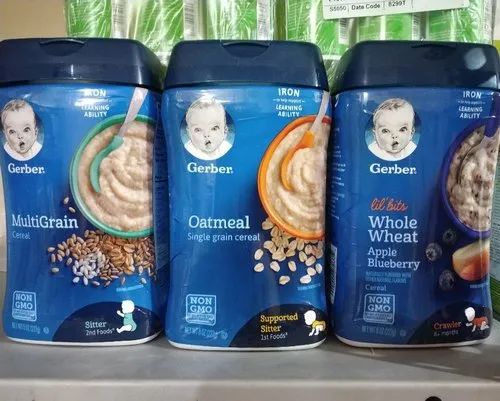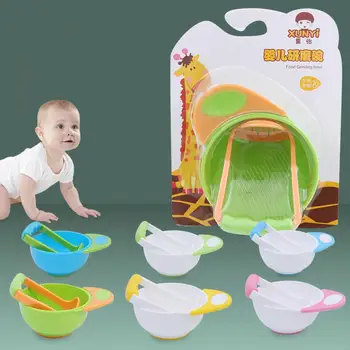Tips for feeding baby food
Feeding Your 4- to 7-Month-Old (for Parents)
Most babies this age are ready to try solid foods. Experts recommend starting solid foods when a baby is about 6 months old, depending on the baby's readiness and nutritional needs.
Be sure to check with your doctor before giving any solid foods.
Is My Baby Ready to Eat Solid Foods?
How can you tell if your baby is ready for solids? Here are a few hints:
- Does your baby swallow food or push it out of their mouth? Babies have a natural tongue-thrust reflex that pushes food back out. Wait until this reflex disappears (typically when babies are 4–6 months old).
- Can your baby support their own head? To eat solid food, an infant needs good head and neck control and should be able to sit up.
- Is your baby interested in food? Babies who stare, reach and grab, and open their mouths for food are ready to try solid foods.
If your doctor gives the go-ahead but your baby seems frustrated or uninterested in solid foods, try waiting a few days before trying again. Breast milk and formula will still meet nutritional needs as your baby learns to eat solid foods. But after 6 months, babies need the added nutrition — like iron and zinc — that solid foods provide.
Do not add cereal or other food to your baby's bottle because it can lead to too much weight gain.
Watch for signs that your child is hungry or full. Respond to these cues and let your child stop when full. A child who is full may suck with less enthusiasm, stop, or turn away from the breast or the bottle. With solid foods, they may turn away, refuse to open their mouth, or spit the food out.
How Should I Start Feeding My Baby Solid Foods?
When your baby is ready and the doctor says it’s OK to try solid foods, pick a time of day when your baby is not tired or cranky. You want your baby to be a little hungry, but not so hungry that they’re upset. So you might want to give your baby a little breast milk or formula first.
Have your baby sit supported in your lap or in a high chair with a safety strap.
Most babies' first food is iron-fortified infant single-grain cereal mixed with breast milk or formula. Place the spoon near your baby's lips, and let the baby smell and taste it. Don't be surprised if this first spoonful is rejected. Wait a minute and try again. Most food offered to your baby at this age will end up on the baby's chin, bib, or high-chair tray. Again, this is just an introduction.
When your little one gets the hang of eating cereal off a spoon, it may be time to try single-ingredient puréed meat, vegetables, or fruit. The order in which you give them doesn't matter, but go slow. Offer foods that are high in iron and zinc — such as meat, poultry, eggs, and beans — especially if your baby is breastfeeding. Try one food at a time and wait several days before trying something else new. This will let you identify any foods that your baby may be allergic to.
Which Foods Should I Avoid?
Foods that are more likely to cause allergies can be among the foods you introduce to your baby. These include peanuts, eggs, cow’s milk, seafood, nuts, wheat, and soy. Waiting to start these foods does not prevent food allergies. Talk to your doctor if you’re concerned about food allergies, especially if any close family members have allergies, food allergies, or allergy-related conditions, like eczema or asthma.
These include peanuts, eggs, cow’s milk, seafood, nuts, wheat, and soy. Waiting to start these foods does not prevent food allergies. Talk to your doctor if you’re concerned about food allergies, especially if any close family members have allergies, food allergies, or allergy-related conditions, like eczema or asthma.
Infants with severe eczema or egg allergies are more likely to have allergies to peanuts. Talk to your doctor about how and when to introduce these foods to your child.
Possible signs of food allergy or allergic reactions include:
- rash
- bloating or an increase in gassiness
- diarrhea
- vomiting
Get medical care right away if your baby has a more severe allergic reaction, like hives, drooling, wheezing, or trouble breathing.
If your child has any type of reaction to a food, don't offer that food again until you talk with your doctor.
Babies shouldn't have:
- foods with added sugars and no-calorie sweeteners
- high-sodium foods
- honey, until after the first birthday.
 It can cause botulism in babies.
It can cause botulism in babies. - unpasteurized juice, milk, yogurt, or cheese
- regular cow's milk or soy beverages before 12 months instead of breast milk or formula. It’s OK to offer pasteurized yogurt and cheese.
- foods that may cause choking, such as hot dogs, raw carrots, grapes, popcorn, and nuts
Tips for Feeding Your Baby Solid Foods
With the hectic pace of family life, most parents try commercially prepared baby foods at first. They come in small, convenient containers, and manufacturers must meet strict safety and nutrition guidelines.
If you prepare your own baby foods at home, here are some things to keep in mind:
- Follow the rules for food safety, including washing your hands well and often.
- To preserve the nutrients in your baby's food, cook it in ways that keep the most vitamins and minerals. Try steaming or baking fruits and vegetables instead of boiling, which washes away the nutrients.
- Freeze portions that you aren't going to use right away.
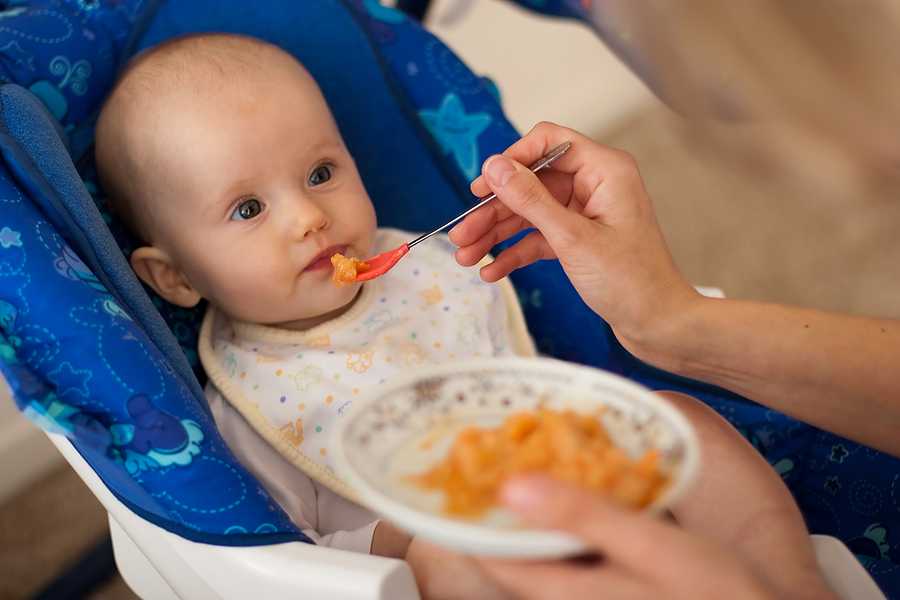
- Whether you buy the baby food or make it yourself, texture and consistency are important. At first, babies should have finely puréed single-ingredient foods. (Just applesauce, for example, not apples and pears mixed together.)
- After your baby is eating individual foods, it's OK to offer a puréed mix of two foods. As babies get older, they will learn to eat a greater variety of tastes and textures.
- If you use prepared baby food in jars, spoon some of the food into a bowl to feed your baby. Do not feed your baby right from the jar — bacteria from the baby's mouth can contaminate the remaining food. If you refrigerate opened jars of baby food, it's best to throw away anything not eaten within a day or two.
- Around 6 months of age is a good time for your baby to try a cup. You might need to try a few cups to find one that works for your child. Use water at first to avoid messy clean-ups. Do not give juice to infants younger than 12 months.
Over the next few months, introduce a variety of foods from all the food groups. If your baby doesn't seem to like something, don’t give up. It can take 8 to 10 tries or more before babies learn to like new foods.
If your baby doesn't seem to like something, don’t give up. It can take 8 to 10 tries or more before babies learn to like new foods.
When can I start giving my baby peanut butter?
Log in | Register
Tips & Tools
Tips & Tools
Listen
Español
Text Size
Question
Amanda Cox, MD, FAAAAI
Answer
Many parents have questions and concerns about when peanut butter can be safely introduced, because it is the leading cause of fatal and near-fatal food allergic reactions in the United States.
New Guidelines on the Introduction of Allergenic Foods:
For many years, experts thought that the best way to fight peanut allergy was to avoid peanut products in the first years of life. At the time, it was thought that delaying introduction would possibly prevent the development of other allergic conditions, especially eczema. However, more recent guidelines show that there is no benefit to delaying the introduction of allergenic foods. In 2015, an important study showed that early introduction and regular feeding of peanut prevented the development of peanut allergy in infants at "high risk" for peanut allergy (meaning infants who had severe eczema and/or an egg allergy).
Advice to Parents:
Start solids with a few foods that are of low allergy risk—for example, infant cereal, puréed bananas, or puréed prunes. Give your baby one new food at a time, and wait at least 2 to 3 days before starting another. After each new food, watch for any allergic reactions such as diarrhea, rash, or vomiting.
 If any of these occur, stop using the new food and consult with your child's pediatrician.
If any of these occur, stop using the new food and consult with your child's pediatrician.If there is no special reason to be concerned that your baby is at increased risk for food allergies, after a few first foods have been tolerated, you can start to introduce the more highly allergenic foods (milk, egg, soy, wheat, peanut, tree nuts, fish, and shellfish). It is important that these—and all foods—are in forms and textures appropriate for infants. For instance, while whole cow's milk is not recommended before 1 year of age; you may introduce processed dairy products such as whole milk yogurt or Greek yogurt mixed with a fruit that your baby has already had in his or her diet.
If your baby has or had severe, persistent eczema or an immediate allergic reaction to any food— especially if it is a highly allergenic food such as egg—he or she is considered "high risk for peanut allergy." You should talk to your child's pediatrician first to best determine how and when to introduce the highly allergenic complementary foods.
 Ideally peanut-containing products should be introduced to these babies as early as 4 to 6 months. It is strongly advised that these babies have an allergy evaluation or allergy testing prior to trying any peanut-containing product. Your doctor may also require the introduction of peanuts be in a supervised setting (e.g., in the doctor's office).
Ideally peanut-containing products should be introduced to these babies as early as 4 to 6 months. It is strongly advised that these babies have an allergy evaluation or allergy testing prior to trying any peanut-containing product. Your doctor may also require the introduction of peanuts be in a supervised setting (e.g., in the doctor's office). Babies with mild to moderate eczema are also at increased risk of developing peanut allergy. These babies should be introduced to peanut-containing products around 6 months of age; peanut-containing products should be maintained as part of their diet to prevent a peanut allergy from developing. These infants may have peanut introduced at home (after other complementary foods are introduced), although your pediatrician may recommend an allergy evaluation prior to introducing peanut.
Babies without eczema or other food allergies, who are not at increased risk for developing an allergy, may start having peanut-containing products and other highly allergenic foods freely after a few solid foods have already been introduced and tolerated without any signs of allergy.
 As with all infant foods, allergenic foods should be given in age- and developmentally-appropriate safe forms and serving sizes.
As with all infant foods, allergenic foods should be given in age- and developmentally-appropriate safe forms and serving sizes.
Choking Prevention:
Whole peanuts themselves are choking hazards and should not be fed to babies. They can block the air passages, and if whole or partially chewed peanuts are inhaled into the lungs, they can cause a severe and possibly fatal chemical pneumonia. Avoid whole peanuts until your child is old enough to be counted on to chew them well (usually at least 4 years and up).
A good way to introduce peanut in infancy would be mixing and thinning-out a small amount of peanut butter in cereal or yogurt. Dissolving peanut butter puffs with breast milk or formula and feeding it by spoon is another good option.
Remember:
The highly allergenic foods should initially be given to your baby in small tastes at home, and the amount can gradually be increased in a developmentally appropriate manner if there are no signs of intolerance or allergic symptoms.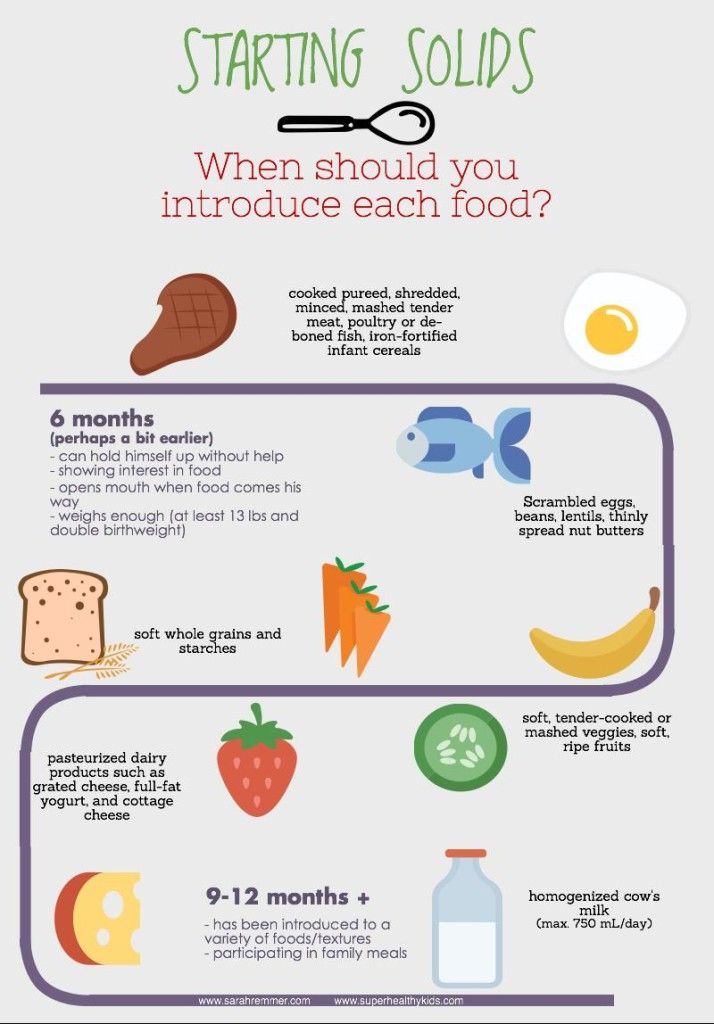
NOTE: The AAP recommends breastfeeding as the sole source of nutrition for your baby for about 6 months. When you add solid foods to your baby's diet, continue breastfeeding until at least 12 months. You can continue to breastfeed after 12 months if you and your baby desire. Check with your child's doctor about vitamin D and iron supplements during the first year. Remember that each child's readiness for solid foods depends on his own rate of development.
Additional Information & Resources:
Working Together: Breastfeeding and Solid Foods
Sample Menu for an 8 to 12 Month Old
Infant Allergies and Food Sensitivities
Peanut Allergies: What You Should Know About the Latest Research
- The Effects of Early Nutritional Interventions on the Development of Atopic Disease in Infants and Children: The Role of Maternal Dietary Restriction, Breastfeeding, Hydrolyzed Formulas, and Timing of Introduction of Allergenic Complementary Foods (AAP Clinical Report)
Amanda Cox, MD, FAAAAI
Amanda Cox, MD, FAAAAI is an Assistant Professor of Pediatrics in the Division of Pediatric Allergy and Immunology at the Icahn School of Medicine at Mount Sinai in New York and a practicing pediatric allergist at Jaffe Food Allergy Institute.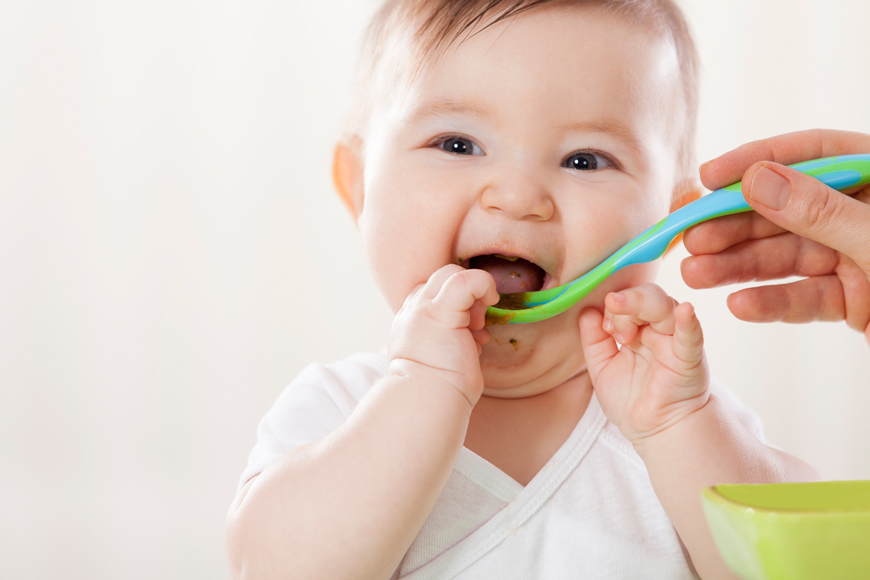 She is a former president of the New York Allergy & Asthma Society and a fellow of the American Academy of Allergy Asthma & Immunology where she serves on the Adverse Reactions to Foods Committee. Dr. Cox is a contributing writer to The Pediatrician's Guide to Feeding Babies and Toddlers and has written several book chapters and review articles in the area of food allergy.
She is a former president of the New York Allergy & Asthma Society and a fellow of the American Academy of Allergy Asthma & Immunology where she serves on the Adverse Reactions to Foods Committee. Dr. Cox is a contributing writer to The Pediatrician's Guide to Feeding Babies and Toddlers and has written several book chapters and review articles in the area of food allergy.
- Last Updated
- 3/17/2019
The information contained on this Web site should not be used as a substitute for the medical care and advice of your pediatrician. There may be variations in treatment that your pediatrician may recommend based on individual facts and circumstances.
Weaning Tips for Babies
Search Support IconSearch Keywords
Home ›› How to Wean Your Baby
close communication. You are now preparing for another exciting milestone - introducing solid foods to your baby's diet. This is an exciting moment when your baby becomes more independent in eating. But, like all other stages of a child's development, this period requires a long adaptation. Like most parents, you probably want to know when to start introducing solid foods and how to introduce solid foods to your baby.
This is an exciting moment when your baby becomes more independent in eating. But, like all other stages of a child's development, this period requires a long adaptation. Like most parents, you probably want to know when to start introducing solid foods and how to introduce solid foods to your baby.
This article contains important information about introducing solid foods to your baby's diet (age-appropriate), tips for introducing complementary foods, and techniques to help you and your baby transition smoothly to the next level of nutrition.
At what age should complementary foods be introduced?
Be sure to check with your doctor when you think your child is ready to introduce new foods. There is no exact age at which complementary foods should be introduced. However, the introduction of complementary foods to children, both breastfed and bottle-fed, is recommended to start at the age of 4-6 months. At 6 months of age, a baby's energy and mineral needs increase.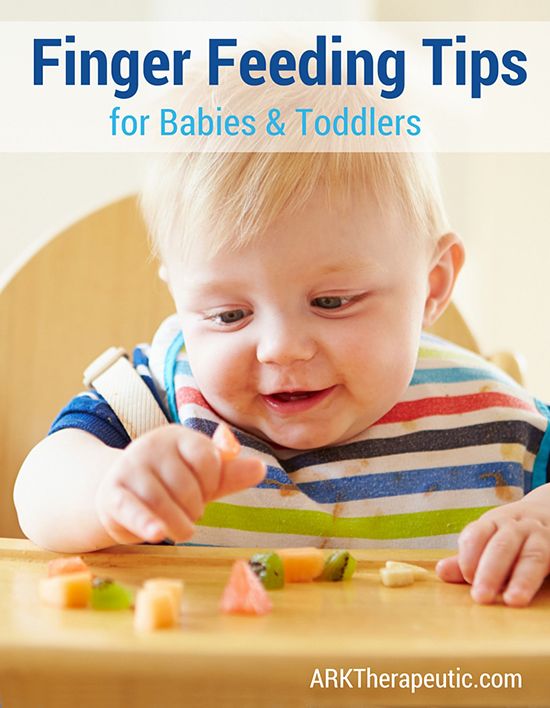 However, all babies are different and some may be ready for it as early as four months. Four months is the earliest age at which complementary foods can be introduced. Until then, the baby's gastrointestinal tract is not ready to absorb any other food besides breast milk or formula. Only a doctor will be able to assess the individual readiness of each child; no matter what his decision is, it is important to continue breastfeeding, gradually introducing solid foods along with it.
However, all babies are different and some may be ready for it as early as four months. Four months is the earliest age at which complementary foods can be introduced. Until then, the baby's gastrointestinal tract is not ready to absorb any other food besides breast milk or formula. Only a doctor will be able to assess the individual readiness of each child; no matter what his decision is, it is important to continue breastfeeding, gradually introducing solid foods along with it.
The doctor will try to identify key signs that your baby is ready for solid foods: [1]
- The baby can sit up without assistance or can sit on mom's lap and hold her head.
- The “spoon push” reflex, a natural reaction of rejection of food, in which the child pushes the spoon out with the tongue (the child no longer sticks out the tongue when eating), has disappeared in the baby.
- The child has an active food interest (desire to try something from the table while adults are eating).

After your baby has mastered the skills necessary for independent feeding, including holding his head well, you can begin to introduce more solid foods into the diet.
Your baby's first foods
The moment you've been waiting for is finally here: your baby is ready to try solid food! Usually the products of the first complementary foods are vegetables and cereals.
If the baby is healthy, has no digestive problems and is gaining weight well, then, as a rule, weaning foods start with the introduction of vegetables.
Monocomponent vegetable purees are good for the first feeding. Vegetables are a source of organic acids, potassium, iron, fiber. It is recommended to start vegetable complementary foods with zucchini, broccoli and cauliflower. Initially, vegetable puree should consist of one type of vegetable. Then you can make a combination of various vegetables. Start with 1 spoon, then bring the volume to 180 grams. By the year, the amount of vegetable purees consumed per day is 200 grams.
By the year, the amount of vegetable purees consumed per day is 200 grams.
If the child is underweight or anemic, industrial cereals can be given as the first complementary food. As the first cereals, in order to avoid allergic reactions, it is recommended to introduce dairy-free gluten-free cereals. Mix one to two tablespoons of single-grain cereal with breast milk, or infant formula, or water. If the child is breastfed, give him complementary foods only after the main feeding, so that the child can first get enough breast milk; keep doing this until he is about
[2]
Once your child is used to their first meal, continue to introduce new foods such as fruit purees, cottage cheese, eggs, dairy products, and meat and fish purees. Before introducing each next product, you must wait three to five days to find out if the child is allergic to the previous one.
Steaming!
The inclusion of various foods in the diet is very important for the formation of taste habits in the baby. Steam a variety of healthy meals!
Steam a variety of healthy meals!
Steaming is one of the healthiest ways to cook baby food. Steamed products are very soft and juicy, unlike fried products, which, of course, is very popular with children. And most importantly, steamed foods preserve the most important vitamins and minerals.
Make healthy cooking easy and enjoyable with the Philips Avent 4 in 1 Steamer Blender. The 4 in 1 healthy baby food maker allows you to steam and grind food in one jug. In addition, with the Philips Avent Steamer Blender, parents can make solid foods for babies of all ages, from purees to chunks. Jug with a volume of 1l. designed to cook several servings at a time. So you can prepare several meals at once to feed your baby now, and also freeze the puree for next time in a special container that comes with the steamer. The defrost and keep warm functions will help you prepare lunch or dinner for your baby even faster.
The 4 in 1 Steamer Blender also comes with a recipe booklet developed with pediatric nutritionist Emma Williams. In the brochure you will find interesting recipes for preparing tasty and fresh children's meals, as well as useful tips on the introduction of complementary foods and interesting menu ideas. Instill healthy habits in your baby from an early age for healthy development.
In the brochure you will find interesting recipes for preparing tasty and fresh children's meals, as well as useful tips on the introduction of complementary foods and interesting menu ideas. Instill healthy habits in your baby from an early age for healthy development.
In addition to the joy your child will experience from a change in diet, it is important to be aware of the various food allergies that can occur during the introduction of complementary foods. Experts recommend starting to introduce commonly known food allergens when the baby is 4-6 months old. In addition, recent studies have shown that with a later introduction of complementary foods in children, the risk of developing food allergies increases, therefore, it is necessary to introduce such foods into the baby’s diet on time and not put them off for later. The most well-known G8 food allergens include: [2] [3]
- cow's milk;
- chicken eggs;
- fish;
- seafood;
- nuts;
- peanuts;
- wheat;
- soybeans.

If you or a family member has a food allergy, be sure to consult your pediatrician for the best solution for introducing the foods listed above to your child's diet.
In addition to introducing new foods into the child's diet, it is also necessary to teach him to drink water from the age of 6 months. During the first six months of a child's life, mother's milk provides him with the necessary amount of fluid, even in hot climates. But once your baby is 6 months old, you can start giving him little by little to drink from a non-spill cup.
Check out Avent's Soft Non-Spill Training Cup from the Natural series with comfortable handles to help your child learn to drink without help. It is easy to drink from it, because the liquid begins to flow out only when the child bites or sucks on the spout of the cup. The design of the cup makes it easy to hold with little hands.
From Puree to Finely Chopped Foods
Once your child has mastered the motor skills needed to eat more solid foods, you can move on to finely chopped foods. Each child is different, but usually chopped vegetables and meat can be introduced into the diet from nine months. [4]
Each child is different, but usually chopped vegetables and meat can be introduced into the diet from nine months. [4]
When you introduce crushed foods into your child's diet, try to get your child to take an active part in family meals. The baby can be offered boiled vegetables, pieces of soft fruit, well-boiled pasta, or small pieces of chicken.
Remember to check that the ground food is soft and well cooked so that the child can easily grind it into mush with his mouth. Meat, for example, has a tougher structure and fibers, and therefore requires more thorough grinding compared to fruits that are delicate in texture.
With the Philips Avent 4 in 1 Steamer Blender, you can customize your food consistency from puree to chunks. Also, the recipe book that comes with the double boiler will allow you to easily choose the right recipe for the age of the child.
Tips for getting started with solid foods
Here are some basic tips for introducing complementary foods to infants. As you introduce solid foods into your child's diet, we also recommend following other tips to help your child get used to the new food: [1]
As you introduce solid foods into your child's diet, we also recommend following other tips to help your child get used to the new food: [1]
- Offer food only when the child wants it. In a quiet environment or when other family members are having lunch, offer your baby a new product if he wants to try it.
- Introduce a new product in small portions in the morning. A new product should be administered in the morning to monitor possible reactions to the product. Remember that the introduction of new foods into the diet should not be considered a complete meal for the child. It is only about giving the child the opportunity to taste different foods, as well as to get a feel for their structure, gradually increasing their portions as the baby grows older.
- Offer your child a new product only when they are healthy. Do not introduce new foods when the child is sick or during the vaccination period.

- If the child does not like the product, postpone the tasting until a later date. This is a new experience for your baby, associated with new tastes and sensations. Therefore, do not be discouraged and do not worry if the child did not like the food the first time! Simply postpone taking this product until a later time.
- Never leave your child alone with food. Although the child is already taking the first steps in independent nutrition, this does not mean that he can be completely independent.
- Do not give your child foods that are too hard or slippery, rounded or choking on. These precautions will prevent the child from suffocation. Any rounded foods, such as grapes or carrots, should be cut into two or four pieces.
Goodbye liquid diet!
Proper weaning is an unforgettable experience for you and your baby. Complementary foods are very different from breastfeeding and bottle feeding, and you will certainly feel a sense of pride as your baby matures. Enjoy these precious moments. After all, before you know it, your child will grow out of his highchair and move on to a full three-course meal!
Enjoy these precious moments. After all, before you know it, your child will grow out of his highchair and move on to a full three-course meal!
Download the app and use trackers to track your child's development and growth, and keep those special moments forever.
Download app:
You are leaving the Philips Healthcare (“Philips”) official website. Any links to third party websites that may be included on this site are provided solely as a convenience to you. Philips makes no warranties regarding any third party websites or the information they contain.
I understand
You are about to visit a Philips global content page
You are about to visit the Philips USA website.
Union of Pediatricians of Russia
Complementary feeding
How to introduce complementary foods correctly is one of the most pressing issues that concern parents.
In the first months of life, the main food for the baby is breast milk or an adapted milk formula, however, as the child grows and develops, this becomes insufficient and it is necessary to think about the introduction of complementary foods.
Your baby is over 4 months old. He has noticeably grown up, become more active, is interested in objects that fall into his field of vision, carefully examines them and reaches for them. The child's emotional reactions have become much richer: he smiles happily at all people, makes various sounds. Perhaps you notice that the child looks into your plate with interest, closely monitors what and how you eat, does this mean that it is time to introduce complementary foods? And where is the best place to start? Let's figure it out!
When should complementary foods be started?
According to the Program for optimizing the feeding of infants in the first year of life in the Russian Federation (2019), the recommended age for the introduction of complementary foods is in the range from 4 to 6 months.
The following points will help determine the readiness of the baby for the introduction of complementary foods:
1. Food interest - you can check its presence as follows: during your meal, give the baby an empty spoon or fork, and if he plays with it, licks it, then there is no food interest yet; but if the child is dissatisfied with the fact that the spoon is empty, food interest has probably appeared.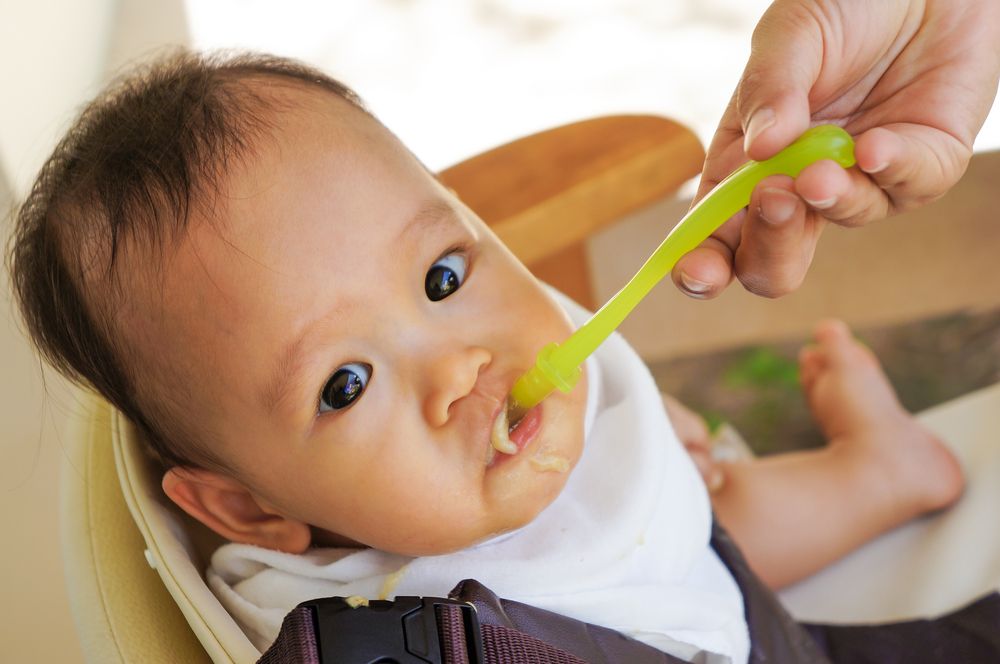 “But how does a child understand that there should be food in a spoon?” Parents often ask. The answer is quite simple: take your baby to the table with you so that he can see how you eat!
“But how does a child understand that there should be food in a spoon?” Parents often ask. The answer is quite simple: take your baby to the table with you so that he can see how you eat!
2. The child can sit alone or with support. It is unacceptable to feed the child lying down, because he may choke.
3. Extinction of the “pushing out” reflex - when the baby pushes out of the mouth both the offered food and the pacifier, etc.
Why is it not recommended to introduce complementary foods before 4 and after 6 months of life?
Before 4 months of life, the baby is not yet ready to digest food other than breast milk or infant formula. By this age, a number of digestive enzymes mature, a sufficient level of local immunity is formed, which reduces the risk of developing allergic reactions, the child acquires the ability to swallow semi-liquid and thicker food, which is due to the extinction of the “spoon ejection reflex”. The introduction of complementary foods after 6 months can cause a pronounced deficiency of micronutrients (iron, zinc, etc. ) and lead to a delay in the formation of chewing skills for thick foods. Too late the introduction of a variety of products increases the risk of allergic reactions. Remember that the timing of the introduction of complementary foods is set individually, taking into account the readiness of the child to accept new foods.
) and lead to a delay in the formation of chewing skills for thick foods. Too late the introduction of a variety of products increases the risk of allergic reactions. Remember that the timing of the introduction of complementary foods is set individually, taking into account the readiness of the child to accept new foods.
Complementary feeding guidelines:
1. introduce a new product in the first half of the day to track possible reactions to it;
2. cereals, vegetable / fruit / meat purees should be introduced, starting with monocomponent ones, gradually adding other products of this group;
3. start giving a new product with 1/2 teaspoon, gradually increasing the volume to the age norm within a week;
4. It is not recommended to introduce new products during acute infectious diseases or at some special moments (moving to another apartment, leaving the city, on vacation, illness of parents, etc.).
What is the best way to start complementary foods?
The first complementary food can be anything. Often parents worry that if the child first tries the fruit, then because of its sweet taste, he will refuse other foods. We hasten to reassure you: breast milk is also sweet, so babies may like sweet fruits / berries more, but this does not mean at all that he will refuse vegetables or cereal. Traditionally, they begin to introduce complementary foods in the form of mashed potatoes, but if the child shows interest in “pieces”, then, observing the safety rules, you can give them. Also, along with the introduction of complementary foods, you can offer the child water.
Often parents worry that if the child first tries the fruit, then because of its sweet taste, he will refuse other foods. We hasten to reassure you: breast milk is also sweet, so babies may like sweet fruits / berries more, but this does not mean at all that he will refuse vegetables or cereal. Traditionally, they begin to introduce complementary foods in the form of mashed potatoes, but if the child shows interest in “pieces”, then, observing the safety rules, you can give them. Also, along with the introduction of complementary foods, you can offer the child water.
With the start of the introduction of complementary foods, the child is gradually transferred to a 5-time feeding regimen. If the baby shows that he is full and does not want to eat anymore (for example, leaning back or turning away from food), then you should not continue to force feed him, because this can lead to eating disorders in the future. Also, do not force the child to eat as much as possible before bedtime in the hope that he will not wake up for nightly feedings.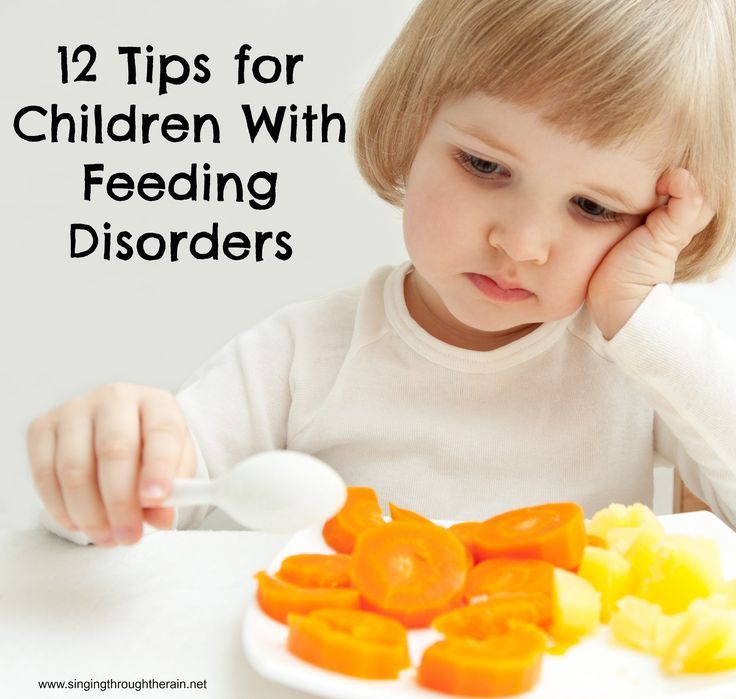
Traditionally, in our country, complementary foods begin with vegetables or cereals.
Vegetables: zucchini, broccoli, cauliflower, pumpkin, etc. If the child did not like the dish, for example, broccoli, do not give up on your plan and continue to offer this vegetable in small quantities daily, you can even not once, but 2-3 times, and after a while (7-14 days) the baby will get used to the new taste. This diversifies his diet, will help form the right taste habits in the child.
As for cereals, it is worth starting with dairy-free gluten-free ones - buckwheat, corn, rice. You can use commercial baby food porridge, which is enriched primarily with iron. In addition, such porridge is already ready to eat, you just need to dilute it with water, which will save you a lot of time.
It is also recommended to add oil to food, for example, vegetable puree to vegetable puree, and butter to porridge.
Of meat products, lean meats, such as mashed turkey or rabbit, are most preferred to start complementary foods. Meat puree contains iron, which is easily absorbed, and adding meat to vegetables improves the absorption of this micronutrient from them. Subsequently, the daily use of children's enriched porridge and mashed meat allows you to meet the needs of babies for iron, zinc and other micronutrients.
Meat puree contains iron, which is easily absorbed, and adding meat to vegetables improves the absorption of this micronutrient from them. Subsequently, the daily use of children's enriched porridge and mashed meat allows you to meet the needs of babies for iron, zinc and other micronutrients.
When introducing fruit purees (apple, pear, peach, prunes, etc.) into your baby's diet, you should pay special attention to the composition of the product - it is important that it does not contain added sugar.
Fish is a source of easily digestible protein and contains a large amount of polyunsaturated fatty acids, including the omega-3 class, as well as vitamins B2, B12, and minerals. Preference should be given to oceanic fish, preferably white (cod, hake, pollock, sea bass, etc.), salmon can be recommended from red, and pike perch from river.
Fermented milk products are prepared using a special starter culture that breaks down milk protein, so that the baby can get an indispensable set of amino acids in a well-available form. Some foods have added prebiotics, certain vitamins and minerals. Their regular use favorably affects the functioning of the intestines, increases appetite and the absorption of micronutrients.
Some foods have added prebiotics, certain vitamins and minerals. Their regular use favorably affects the functioning of the intestines, increases appetite and the absorption of micronutrients.
Recommendations and timing of the introduction of complementary foods for children at risk of developing food allergies and suffering from food allergies are the same as for healthy children. Delayed introduction of highly allergenic foods has previously been recommended to prevent the development of allergic diseases in children at risk. There is now evidence that this practice may lead to an increase rather than a decrease in the incidence of food allergies. The most common highly allergenic foods include cow's milk, chicken eggs, soybeans, wheat, peanuts, tree nuts, shellfish and fish. If a child has a high risk of developing allergies or an existing allergic disease, it is recommended to consult a pediatrician, an allergist-immunologist before introducing highly allergenic products.
By the age of 8 months, when all the main food groups have already been introduced and your baby is improving his skills to eat on his own, special attention should be paid to the diversity of the composition of dishes and the change in food consistency - from puree to finely and coarsely ground. Soft foods cut into small pieces (fruits, vegetables, meat, etc.) are perfect for a little gourmet, which diversifies his diet and will contribute to the formation of chewing skills.
By 9-12 months, most babies have the dexterity to drink from a cup (holding with both hands) and to eat foods prepared for other family members. This behavior needs to be encouraged, but combined with regular feeding to meet energy and nutrient requirements.
It is advisable to use industrial products that are designed specifically for young children after a year.
What should not be given to the baby?
It is not recommended to add salt or sugar to food to enhance the taste.
Drinks that should be avoided include fruit juices, whole cow and goat milk (whole milk is not recommended for children under one year old, and even longer, due to a high risk of developing iron deficiency and increased stress on the kidneys), sweet fruit drinks, compotes and carbonated drinks.
Also, some foods should be excluded from the diet of infants: solid round foods (for example, nuts, grapes, raw carrots, raisins, peas, etc.), due to the fact that the child can choke on them.
It is not recommended to eat products with added sugar, for example, confectionery (marshmallow, marshmallow, marmalade, jam, jam, cookies, waffles, etc.), etc.
You should not give your child the meat of large predatory fish (shark, bigeye tuna, king mackerel, swordfish): these types of fish accumulate more harmful substances than others.
It is forbidden to give honey to children under one year old due to the fact that it may contain spores of Clostridium botulinum bacteria, which in the still immature digestive system of babies are able to multiply, produce toxins directly inside the intestines and, thus, cause infant botulism, which can be fatal.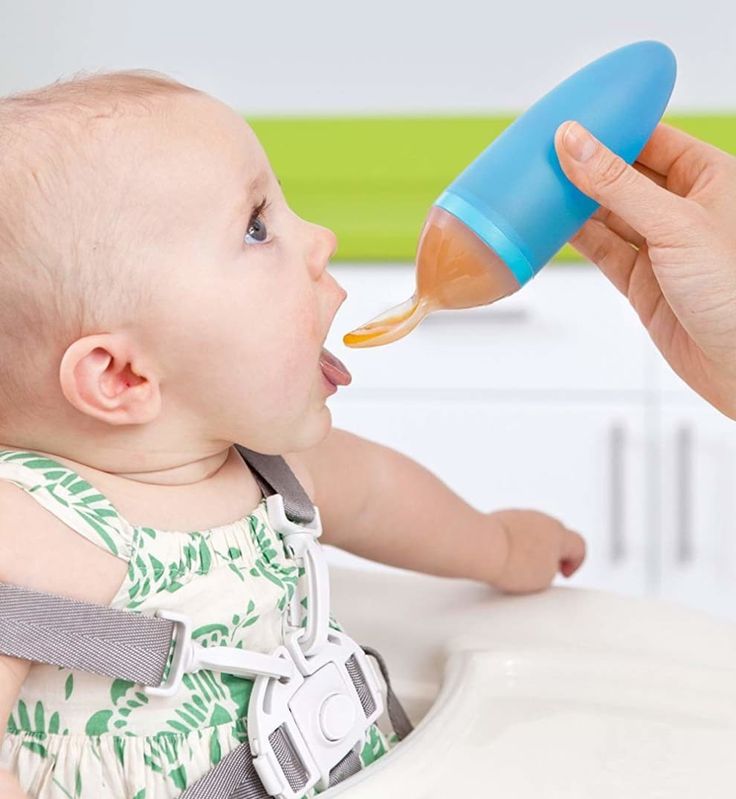 outcome.
outcome.
Do not give babies raw meat, fish, eggs, caviar, salted fish, soft pickled cheeses because of the risk of intestinal infections.
If you follow all these simple rules, your baby will grow up healthy and happy!
Diets for different ages
References:
1. Methodological recommendations. The program for optimizing the feeding of children in the first year of life in the Russian Federation. [Internet]. - M.: Union of Pediatricians of Russia, 2019. [Methodicheskie rekomendaczii. Programma optimizaczii vskarmlivaniya detej pervogo goda zhizni v Rossijskoj Federaczii. [Internet]. – Moscow: Soyuz pediatrov Rossii, 2019.(In Russ.).] Available: http://www.pediatr-russia.ru/information/dokumenty/other-docs/nacprog1year_2019.pdf Link active as of 20.04.2020
2. Duryea T.K. Introducing solid foods and vitamin and mineral supplementation during infancy. In: Post T, ed. UpToDate . Waltham, Mass.: UpToDate; 2020.










